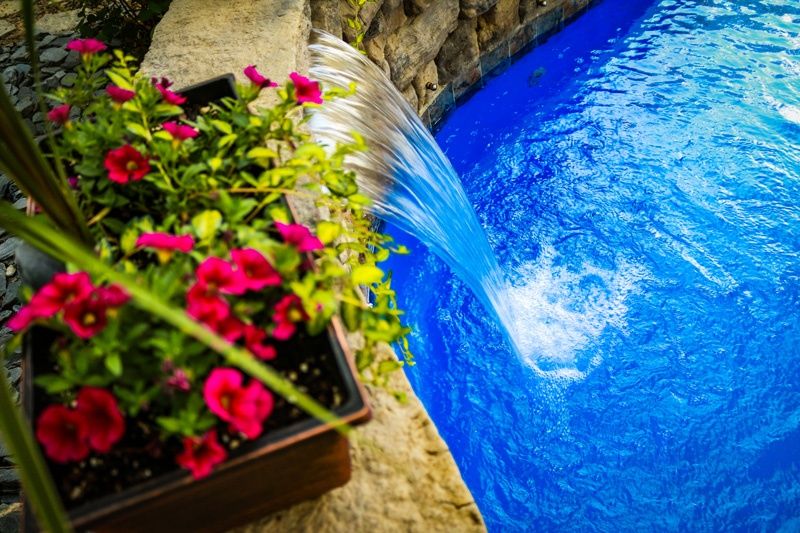
Humans are hard-wired for waterfalls. A visit to natural falls is often the highlight of any trip. Artificial waterfalls can make the difference between a ho-hum experience and something unforgettable, whether you encounter in a restaurant, a front yard, or next to a well-built backyard pool.
You’re probably thinking about adding a waterfall feature to your inground pool, which led you to this page. Let’s discuss all the key details of pool waterfalls, so you can decide whether you should build one, what you can expect if you do… and why you might want to think twice before building that extra-elaborate waterfall you’ve been dreaming about.
What is a pool waterfall?
An artificial waterfall connected to a swimming pool is sometimes called a grotto. The terms are usually interchangeable. All functional pool waterfalls share several common features and functions:
- A pool waterfall starts above the pool’s waterline
- Water flows over the “fall” through powered pumps
- Any functional waterfall will need some extra maintenance
Pool waterfalls come in a wide range of shapes, sizes, and designs, and can be constructed with natural materials (like some convenient local rocks) or artificial materials, typically concrete, bricks, or synthetic structures. Some builders can install pre-formed waterfalls made from molded concrete. You might even find plastic waterfall structures if you look hard enough -- but we wouldn’t recommend it!
Artificial waterfalls use powered pumps to pull water up to the top level, or spillway, of a waterfall structure. Some waterfalls can be built into the upper lip of the pool, roughly at ground level, making their “structure” part of the pool itself. Others flow from raised walls or more extensively designed structures overlooking the pool.
No matter how they’re designed, all functional pool waterfalls need pumps to move water upwards against the pull of gravity. No pump, no waterfall.
Waterfalls can be integrated into elevated tanning ledges or spas as well. Integrated waterfalls might sacrifice some natural aesthetics, but they often provide more functionality than a natural stone waterfall. You’ll see some examples of integrated waterfalls further in this article. You can create a “natural” design around a functional waterfall as well, but this will typically cost more than placing pump systems in the right places on pool designs with different elevations.
What are the benefits (pros) of pool waterfalls?
You know pool waterfalls can look fantastic. But did you know they can also make you feel fantastic? The sound of gently rushing water can be calming and therapeutic -- there’s a reason so many “go to sleep” soundtracks include the sound of waterfalls or ocean tides. Here are some key benefits of a pool waterfall:
- Aesthetics
- Therapeutic value (calming sound and visuals)
- Can block background noises when operating
- Water circulation (adds several related benefits)
- Cooling effects (in hot climates)
- Can enhance filtration and reduce algae build-up
- Can increase play area (when properly designed)
- May add value to your home (compared to a waterfall-less pool)
The sound of an active waterfall can also muffle less enjoyable background noises, like nearby traffic, the hum of running pool equipment, various annoying birds and insects. If you’re prone to overthinking, the sound of your pool waterfall can help you turn down that inner monologue and just relax.
The pumps keeping water moving over your waterfall ledge(s) have functional benefits, too. Your primary pool filter uses pumps to circulate water through its mechanisms, which traps gunk and prevents stagnant water from fouling the pool.
A waterfall can connect to your filtration system or be used to augment it, adding extra circulation and sweeping more gunk out of your way before it becomes a problem. Flowing water takes longer to heat up than calm, flat water, so many pool owners use waterfall features to moderate heat build-up during the dog days of summer.
Falling water can also oxygenate your pool, which works with the movement of the water itself to reduce harmful particles and prevent algae growth. This won’t replace your primary filtration system, but it can extend its lifespan and allow you to reduce your use of chemical treatments.
Larger pool waterfall installations can also be used to hide equipment and machinery. You might even install entertainment features, like lighting and sound systems, to create an instant party in your backyard oasis. However, the cost of a pool waterfall will rise quickly as you add more functionality (and height and/or decoration) to its design.
How much do pool waterfalls cost?
A simple cascade-style waterfall, which can be built into the side of an inground pool or incorporated into a raised wall, will cost between $1,000 and $4,000, based on how wide or long they are. Cascade waterfalls are just devices that create a strip of falling water, and this price doesn’t include the cost of any decorative structures around them.
Many pool owners incorporate waterfalls into lagoon-style pool designs. The naturalistic curves of a lagoon pool make a great complement for other “natural” accessories, too.
If your heart’s set on a grotto-style waterfall structure, keep in mind these features often increase pool construction costs by roughly 10% to 15% up front. Dedicated waterfall pumps can increase your operating costs by $30 to $50 a month, per pump (some extra-large waterfall installations need multiple pumps). However, smaller waterfall features like cascade strips can run off of your existing pumps and may not add any notable operating costs.
If you want to add an elevated waterfall feature to your pool, you can expect to spend at least $5,000. Some of the largest and most elaborate pool waterfall installations can cost $25,000 or more -- as with any construction project, the sky’s the limit once you start scaling up your ambitions.
What else can you do with your pool waterfall?
A pool waterfall feature can be as big and bold as your budget allows.
Here are a few ideas for waterfall features and functions you might want in your pool…
A tanning ledge
Tanning ledges can incorporate a huge range of creative design ideas. Your waterfall can spill into the shallow tanning ledge area of your pool, or you can build a tanning ledge area into the waterfall itself. Here are a couple of great examples:
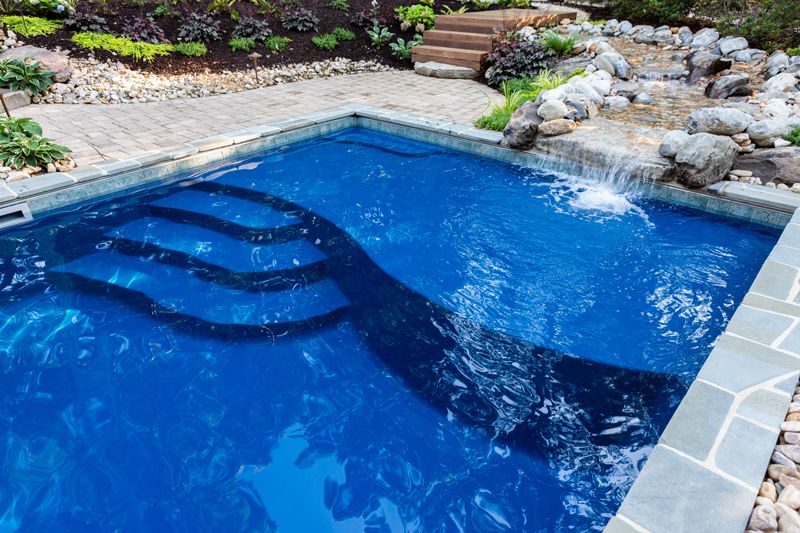
A waterfall spilling into one of our D Series pools.
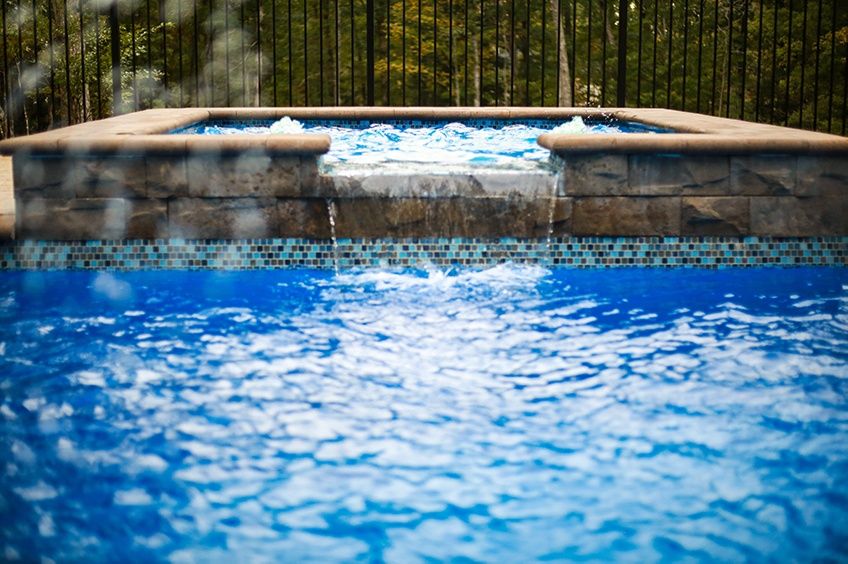
A waterfall spillway between a tanning ledge / spa and pool.
If you’re looking for other great ways to incorporate waterfalls into your pool design -- or if you’d just like more pool design ideas in general -- check out our detailed list of 25 Small Inground Pool Ideas for All Budgets. You can also look at our comprehensive Fiberglass Pool Designs 101 guide, which includes an animated GIF flyover of the tanning-ledge rock waterfall pictured just above.
Retaining walls
Many pool owners build waterfalls into walls surrounding their pools. A retaining wall can lead to higher elevations, or simply provide separation between the pool and the rest of the yard. Here are a few examples of retaining wall waterfalls:
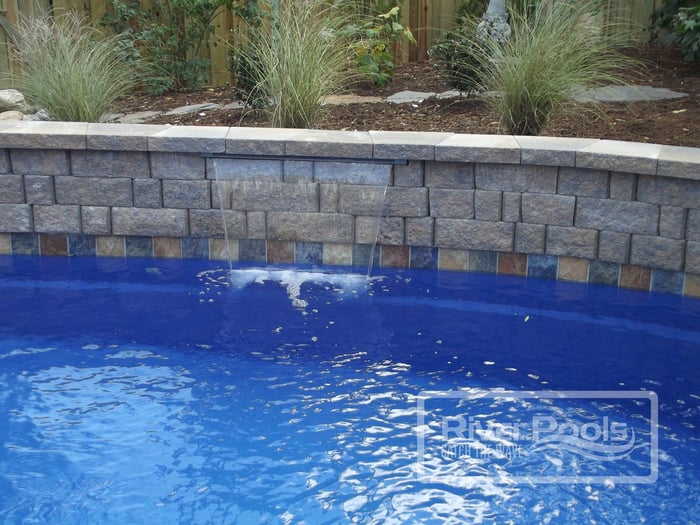
A cascade waterfall built into a retaining wall.
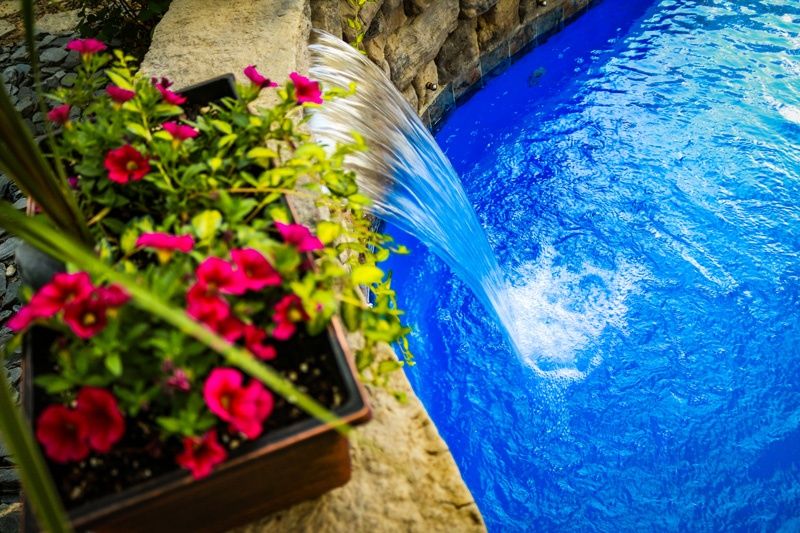
Another cascade waterfall in a retaining wall.
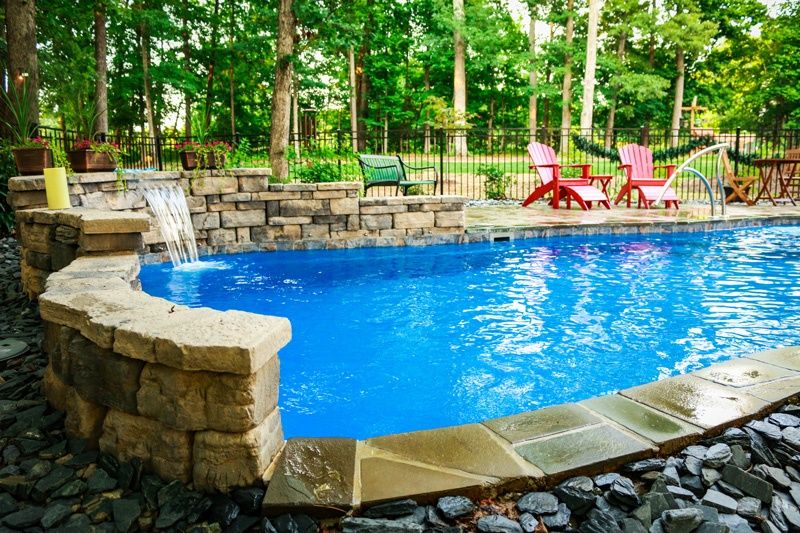
High-elevation spillways
Some folks want their waterfalls to drop down from a second-story spillway. Elevated waterfalls can be breathtaking additions to your backyard oasis:
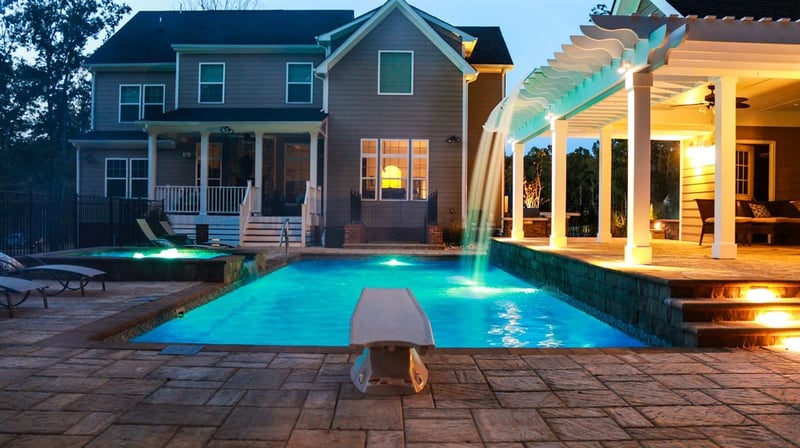
An elevated cascade waterfall on the roof of a guest house entrance.
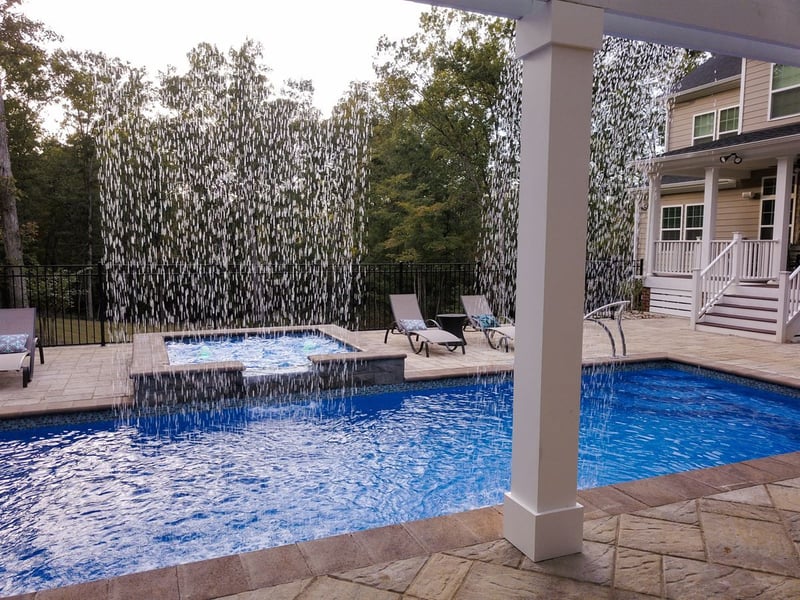
This waterfall is pretty cool, isn't it?
An integrated spa or hot tub
Spas and hot tubs are natural complements for pool waterfalls. Your waterfall can either empty into the spa or hot tub, or spill over from an elevated spa or hot tub to the main pool area below…
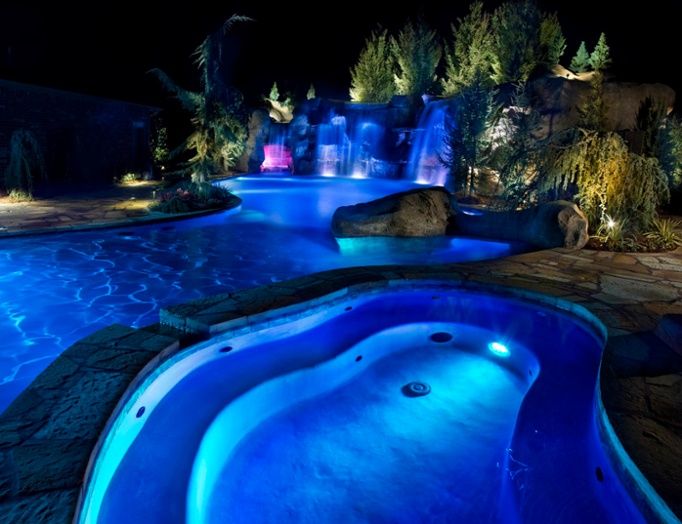
Image from Caviness Landscape Design, Flickr.
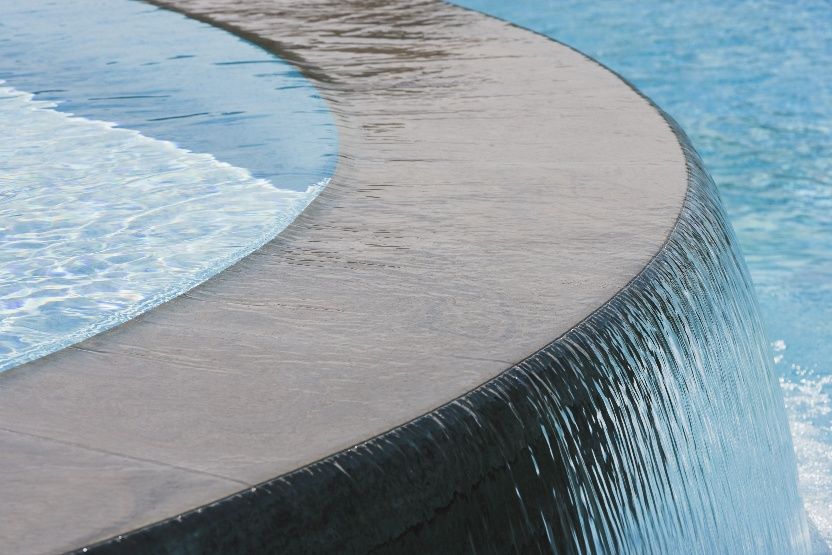
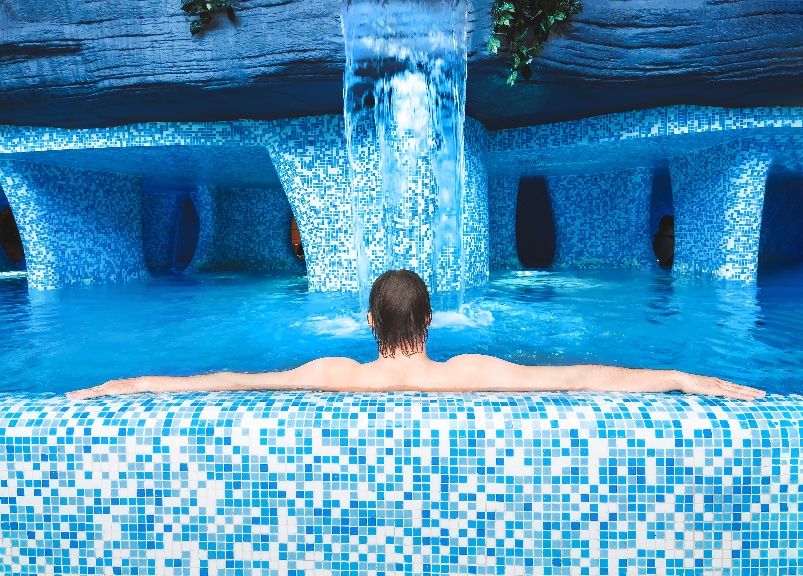
Hidden grottoes
Some pools include elaborate grottoes or “hidden” areas behind or adjacent to their waterfalls. These features come at the high end of your design possibilities, but they can provide truly unforgettable experiences if you’re willing to keep them maintained…
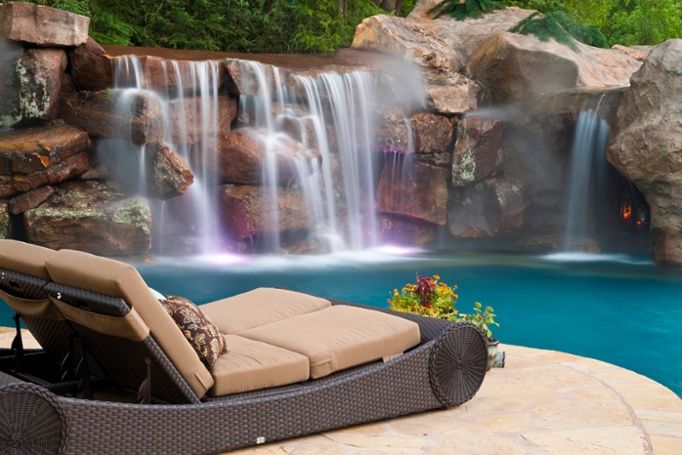
Image from Caviness Landscape Design, Flickr.
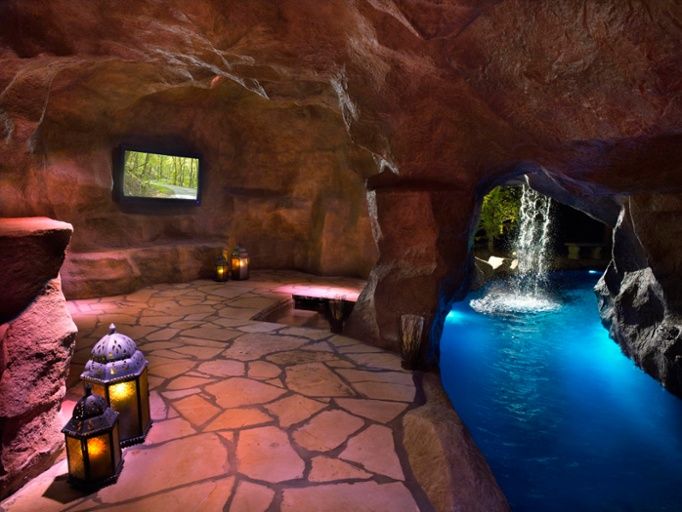
Image from Caviness Landscape Design, Flickr.
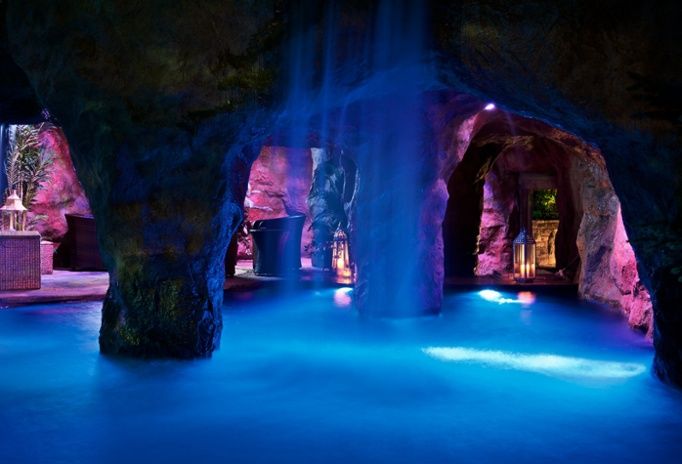
Image from Caviness Landscape Design, Flickr.
You can incorporate all kinds of features and functions into your pool waterfall. The only real limits are your budget and your pool builder’s ability.
Keep in mind that the more complex your construction, and the more falling water is involved in your design, the harder your waterfall area may be to maintain and keep clean over the long run.
What are the drawbacks (cons) of pool waterfalls?
The bigger your waterfall installation, the harder it will be to clean. The materials you use in construction also impact its long-term costs -- artificial rocks or pre-formed structures may erode over time, particularly if you have a saltwater pool.
As you can see, there are a ton of variables at play when we talk about maintaining a pool waterfall. Pumps eventually break and need to be replaced. Gunk can build up in nooks, crannies, and crevices.
A larger and more exposed waterfall feature may be more at risk of weather damage, particularly if you live in an area prone to extreme weather, like hurricanes or high winds.
Make sure to ask your pool builder to tell you about any expected risks, costs, and concerns before building a pool waterfall. We typically recommend cascade waterfall installations.
How can you keep your pool waterfall clean?
Professional pool cleaners should be able to take care of a dirty pool waterfall. However, if you’re more the do-it-yourself type, you can tackle regular cleanings with a good scrubbing brush and some dish soap. This should be done every one to three months, depending on how much calcium builds up on the surfaces of your pool waterfall.
Make sure your waterfall pump is off and all water has been drained from the pool waterfall before you start cleaning it. If the waterfall is made up of natural stones, you may be able to remove and clean them individually. Otherwise, you might spend some time in uncomfortable positions to get at every dirty nook and cranny. A high-pressure garden hose or a proper pressure washer might also do the trick if your waterfall structure is sturdy.
During the offseason, it’s generally best to disconnect any dedicated pumps and filters from your pool waterfall, drain the structure, and store your equipment in a secure space -- preferably indoors.
Want a new pool with a waterfall? Let’s talk!
If you're shopping around for a fiberglass pool -- with or without any waterfalls -- feel free to take a look at our catalog of models, visit our extensive video library, try out our pool cost calculator, or request custom pricing using the button below.
Editor's note: This article was updated on September 5, 2023.
Jason Hughes is a partner at River Pools Virginia, a fiberglass pool installation company based in Warsaw, Virginia. With over 20 years of hands-on experience, Jason has dedicated his career to helping families create beautiful, functional backyards while ensuring every fiberglass pool installation meets the highest standards of quality and safety. In addition to his work with homeowners, Jason serves as a GENESIS instructor with the Pool & Hot Tub Alliance (PHTA), where he teaches fiberglass pool installation best practices to pool professionals across the country. Whether he’s on a job site or leading a training session, Jason is passionate about raising the bar for fiberglass pool installations and helping families make confident, informed decisions as they transform their outdoor spaces.
Topics:

